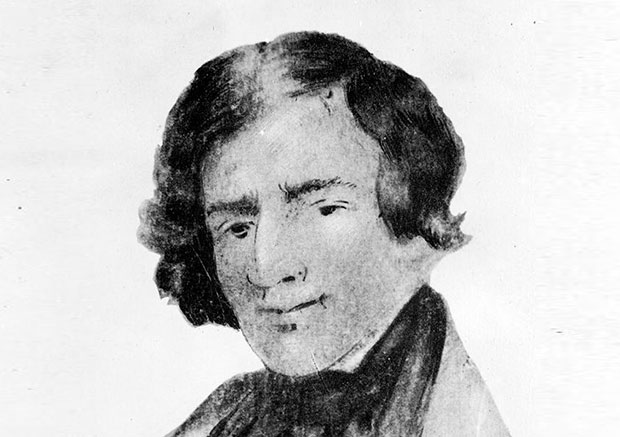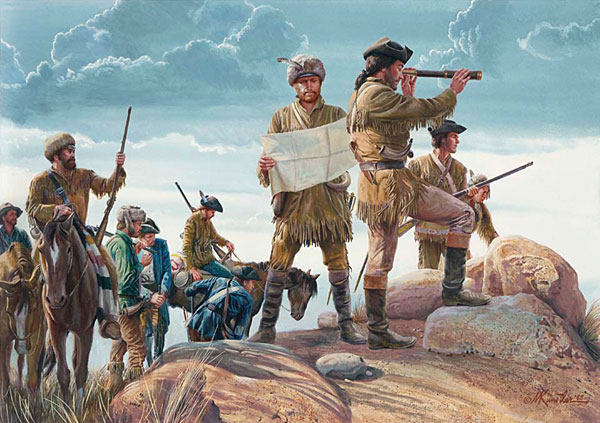It is estimated that there were only about 3,000 mountain men and trappers at the peak of the fur trade. Some would become legends in their own time, others would be recognized later. That some were anti-social outcasts from society only added to the myths, tall tales and downright prevarications that are part and parcel of “The Mountain Men”.
Here are a few of these intrepid souls, some of their adventures and their contributions to the knowledge of what was an unexplored wilderness.

Jedediah Strong Smith was born January 6, 1799 in upstate New York. Sometime in 1822, 23 year old Smith joined “Ashley’s Hundred” and entered Fort Henry at the Mouth of the Yellowstone River October 1st, leaving supplies and continuing up river to the mouth of the Musselshell. The following spring Smith was involved in a fight with Arikara warriors that made his reputation as a fighter and leader. An encounter with a grizzly left Smith with scars that he covered by long hair. Ashley would dispatch Smith and Thomas (Broken Hand) Fitzpatrick to search out a viable route through the Rocky Mountains. Smith would learn of South Pass from friendly Crow Indians, at the Green River the party split in order to trap both upstream and downstream on the Green. The two parties reunited on the Sweetwater River in July; Fitzpatrick was chosen to report to Mr. Ashley in St. Louis. Smith went back over South Pass and may have begun “poaching” trappers from other fur companies for Ashley and Henry’s “Rocky Mountain Fur Company”. The “First Rendezvous” of 1825 Smith was offered a partnership, by the Second Rendezvous” of 1825 both Henry and Ashley had sold their shares of the company to the consortium of Jedediah Smith, David Jackson and William Sublette. Ashley agreed to broker the furs forwarded to St. Louis and send supplies to any future “Rendezvous”. On August 7, 1826 Smith began his first trip into California, first by traveling south to the Colorado River and being guided by Mojave Indians across the Mojave Desert via the western end of the Old Spanish Trail. Arrested as a suspected spy on or about December 8th, Smith would be detained by the Spanish Governor for two weeks and then ordered to leave California by the route by which he entered. Smith and his men would leave in February 1827 but turned north looking for the mythical “Buenaventura River’ the supposedly cut through the Sierra Nevada Range. Time restraints would force him to leave his men in a camp on the Stanislaus River. They would traverse the Great Basin Desert in a summer crossing Smith arrived at the Rendezvous of 1827 on July 3rd. Smith’s return to California with 18 men and two women became a fight for survival against hostile Indians with 10 men killed and the women abducted. Smith and the eight survivors finally reunited with his men September 19, 1827. Arrested again, and released again this time with a bond and ordered to leave California and not return, Smith and his men would take several months to reach the Oregon Country. A squabble over an ax turned deadly July 14, 1828, the result being 15 men massacred by Umpqua Indians. Smith would winter at Fort Vancouver returning to meet with his partners in 1829. After another successful trapping and trading expedition into Blackfeet country in 1829-30, Jedediah Smith, David Jackson and William Sublette sold their firm to Tom Fitzpatrick, Milton Sublette, Jim Bridger, Henry Fraeb and John Baptist Gervais at the rendezvous of 1830. Upon his return to St. Louis, Smith informed the Secretary of War John Eaton of his appraisal of British intentions in the Oregon Country. He then joined his partners in making some basic maps of the known west. While scouting for a trading venture to Santa Fe he would encounter a band of Comanche only to be killed in the encounter May 27, 1831 at 32 years of age.

Related: Of Mountain Men and Map Makers pt 3

Thomas Fitzpatrick was born in 1799, a firearms accident would leave him with a damaged left hand, he became known as “Broken Hand”. Little is known of Fitzpatrick’s early life but it is speculated that he was an Irish immigrant. He would join William Ashley’s fur enterprise in 1823; survive an Indian fight, journey into the Wind River Country and winter with Jed Smith. Spring of 1824 the trapping party crosses South Pass and begin trapping the Green River Country. Fitzpatrick would become involved in transporting goods to the trappers “Rendezvous” and returning to St. Louis with the furs. He would led a wagon trail to Oregon in 1841 and later employed as official guide to Fremont’s 2nd expedition of 1843-44. He would lead Col. Kearney to Santa Fe in 1845 then forward dispatches for Col. Fremont to Washington DC. He would be appointed Indian Agent in 1846 and work out of Bent’s Fort on the Arkansas River. At Fort Laramie in 1851 he brokered a treaty conference with many of the plains tribes. In his capacity as Indian Agent, he was in Washington the winter of 1853-54 to confer with congressional members where he contracted pneumonia and died February 7, 1854 at age 55.